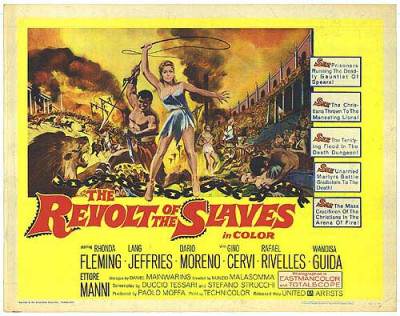| Reviews & Columns |
|
Reviews DVD TV on DVD Blu-ray 4K UHD International DVDs In Theaters Reviews by Studio Video Games Features Collector Series DVDs Easter Egg Database Interviews DVD Talk Radio Feature Articles Columns Anime Talk DVD Savant Horror DVDs The M.O.D. Squad Art House HD Talk Silent DVD
|
DVD Talk Forum |
|
|
| Resources |
|
DVD Price Search Customer Service #'s RCE Info Links |
|
Columns
|
|
|
Revolt of the Slaves, The
Instead, The Revolt of the Slaves turns out to be a different breed of Euro-spectacle. The story, adapted from Irish Cardinal Nicholas Patrick Wiseman's 1854 novel Fabiola, is actually a biblical epic along the lines of The Robe (1953). A lavish, nearly three-hour Italian-French adaptation of Fabiola, starring Michele Morgan and Michel Simon, had been filmed in 1949; its popularity doubtlessly influenced the big production values of The Revolt of the Slaves.
Quite unlike most peplum of the era, this film has huge sets and large throngs of costumed extras. Were these sets constructed specifically for the film, its budget probably would have exceeded $5 million or more, but I suspect the biggest outdoor sets were likely redressed from an earlier epic, possibly the recent Ben-Hur. The enormous Colosseum seen at the climax, for instance, may have been one end of the Circus Maximus from William Wyler's 1959 film. In any case the scale of the production is impressive.
Three centuries after the Crucifixion, Roman Christians are forced into hiding, practicing their religion in the labyrinthine catacombs below the city. Above ground, rebellious slave Vibio (Canadian actor Lang Jeffries) is sold to Roman patrician Fabio (Gino Cervi), the wealthiest man in Rome. At a huge party Fabio refuses an order to fight a professional wrestler, infuriating Fabio's beautiful but spoiled daughter, Fabiola (Rhonda Fleming, Lang's wife at the time), who has the slave lashed. (Fabiola is, inexplicably, called "Claudia" in the English-dubbed version.)
Fabiola also hates Christians, unaware that both her beloved cousin, Agnese (Wandisa Guida) and her father's son-like tribune, Sebastian (Ettore Manni), are secret practitioners. After murdering boss Valerio (Fernando Rey), tossing him into a pit of dogs, scheming Corvino (Serge Gainsbourg) assumes control of Rome's Secret Police and raids the Christians hiding place. Concerned for her cousin, Fabiola agrees to help the Christians, including Vibio (with whom she soon falls in love) escape, despite her lack of faith.
Beyond the surprising scale of the production, another fascinating aspect to The Revolt of the Slaves is its cast. Serge Gainsbourg, the story's ferret-faced villain, was an icon of French popular music, working in every conceivable genre until his death in 1991, including mambo, chanson, reggae, new wave, and funk. He also had the distinction of being married to three French icons himself: Brigette Bardot, Jane Birkin, and Bambou. Georgia-born Vanoye Aikens, who plays the duplicitous leader of the Africans guarding the slaves, was a world-class dancer-choreographer associated with Katherine Dunham's dance company, soon becoming her primary male dance partner. Dario Moreno, who plays the Roman Emperor Maximinus II, was a Turkish polyglot singer and composer, best known for his internationally popular song "Ya Mustafa."
The movie is basically The Robe with a gender swap. Instead of non-believer Roman Centurion Richard Burton falling for Christian Jean Simmons, we get pampered non-believer Roman Rhonda Fleming falling for Christian slave Lang Jeffries. The peplum boom influence is present, as the picture has an entertaining series of action set pieces: the Christians fleeing from the African troops through the catacombs, escape attempts by various slaves, and the big scale finale, with Christians in the Colosseum ordered into a "run of the arrow" situation, with warrior-slaves forced to spear terrified Christians one-by-one.
An Italian-French-West German co-production, the movie wisely puts the Fabiola-Vibio romance on the back burner for most of the story, instead concentrating its energies on the action and Christian persecution angle. For her part, Fleming is serviceable though her Hollywood glamour look is a bit out of place. Her movie career was on the cusp of decline, and she semi-retired from movies, focusing instead on real estate investments that made her rich, a successful Las Vegas nightclub act, and TV appearances. Director Nunzio Malasomma seems to have had a career comparable to Hollywood directors like Allan Dwan: prolific in the silent era and into the late 1940s, but sporadic thereafter. After 1951 he made only three features until his death in 1974, his last being 1967's 15 Scaffolds for a Murderer.
Video & Audio
Licensed by Kino from MGM, The Revolt of the Slaves sources a 103-minute cut, apparently the longest version of the film. Filmed in Totalscope, a four-perf anamorphic process akin to CinemaScope rather than two-perf Techniscope, the film nonetheless is a bit on the grainy side (and likely sourcing secondary film elements), like the latter process, but still quite impressive on big home theater screens. The DTS-HD Master Audio mono is a bit on the thin side, but acceptable and on par for movies like this. No subtitle options and region "A" encoded.
Extra Features
The lone supplement is a U.S. trailer.
Parting Thoughts
Much better than expected, The Revolt of the Slaves comes Highly Recommended.
Stuart Galbraith IV is the Kyoto-based film historian largely absent from reviewing these days while he restores a 200-year-old Japanese farmhouse.
|
| Popular Reviews |
| Sponsored Links |
|
|
| Sponsored Links |
|
|
| Release List | Reviews | Shop | Newsletter | Forum | DVD Giveaways | Blu-Ray | Advertise |
|
Copyright 2024 DVDTalk.com All Rights Reserved. Legal Info, Privacy Policy, Terms of Use,
Manage Preferences,
Your Privacy Choices | |||||||














